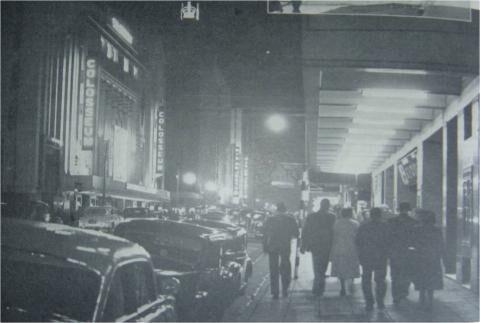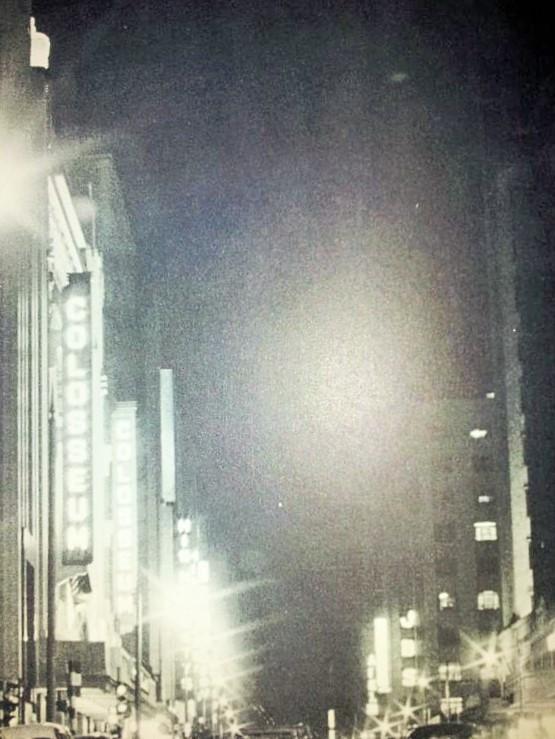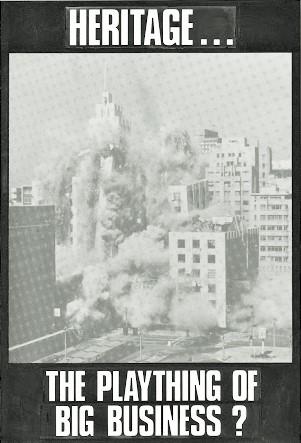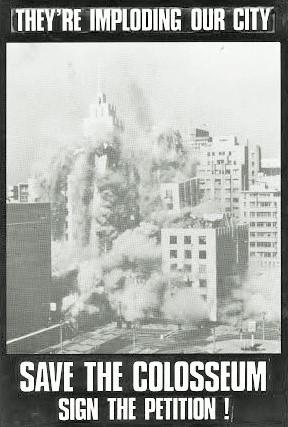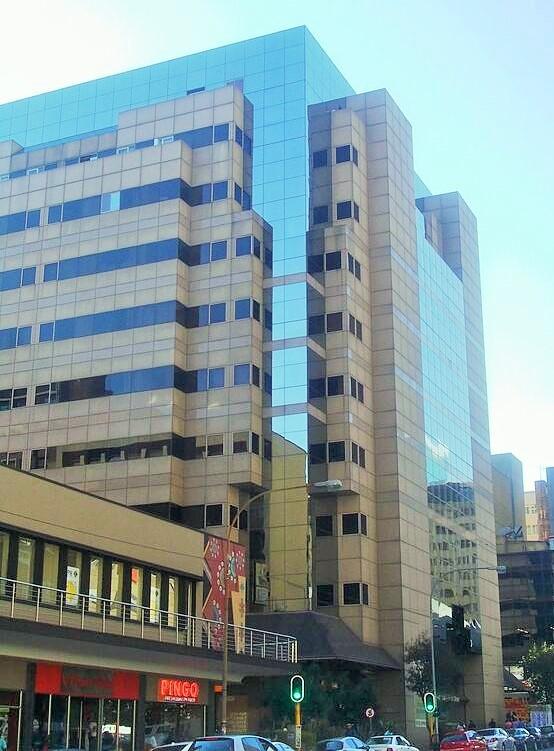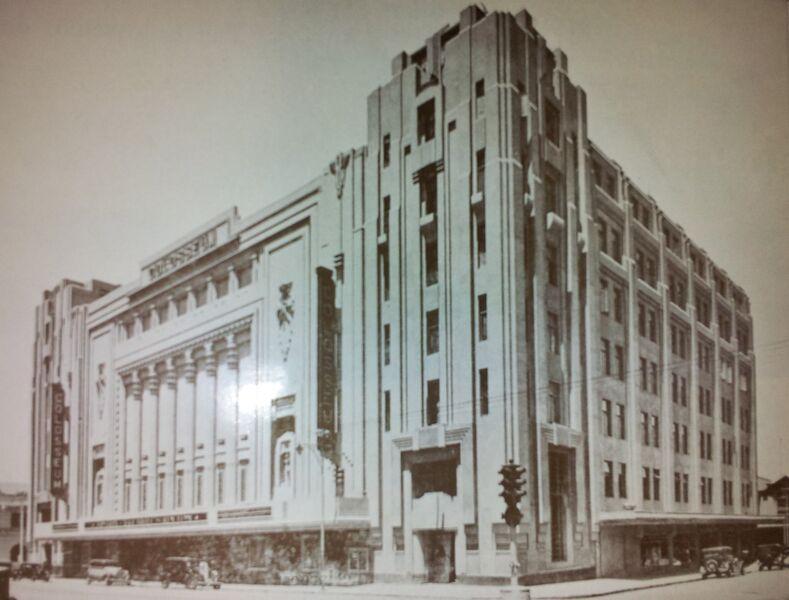
Disclaimer: Any views expressed by individuals and organisations are their own and do not in any way represent the views of The Heritage Portal. If you find any mistakes or historical inaccuracies, please contact the editor.
The Colosseum was an iconic Art Deco Building designed by the architect Percy Rogers Cook and developed by the entertainment mogul I.W. Schlesinger. It occupied an entire city block on Commissioner Street and formed part of the ‘Great White Way’ along with His Majesty’s, Shakespeare House, the CNA Building and others. The theatre could seat over 2 500 people and its ceiling gave the illusion of a star filled night sky above walls built to resemble fairy castles. Over the decades the theatre hosted hundreds of famous productions, actors and musicians. It was also one of the few establishments to hold a multiracial permit during apartheid (this area needs further research as there are differing accounts of the Theatre’s access policy).
In 1983, five years after the historic Markhams Building was saved from demolition, contractors circled the Colosseum waiting for the go ahead to begin work. Below is a summary of the three year battle to save the building based on the work of Nigel Mandy (ex chairman of the CBD Association and manager of the Carlton Centre during its heyday).
Colosseum Theatre at Night (Seventy Golden Years)
The number of large theatres located in the city centre declined during the 1970s and by 1981 only The Colosseum remained. It was too large to be used as a cinema and its facilities were inadequate for modern theatre productions. A few travelling acts still used it occasionally but the revenue barely covered the maintenance costs and property tax on the building. The tough financial situation motivated Sanlam, the owners at the time, to design a plan which involved demolishing the theatre and redeveloping the site for office and retail use.
The CBD Association initially took up the cause. They saw an opportunity to create a major theatre, concert and convention venue as a gift to the city for its centenary in 1986. They managed to secure a six-month purchase option and feasibility studies on the project began in January 1982. Strong support was received from theatre personalities and the Heritage Committee of the Institute of Architects. A team of skilled volunteers including Sidney Abramowitch and Herbert Prins was assembled to produce economical plans to adapt the building for the new use. Shops and offices would be included to generate revenue to subsidise the theatre operations. The purchase price of the building was six million rand and the renovations and improvements were estimated to cost an additional eight million rand. How would the money be raised?
Another shot of the Colosseum at night (Seventy Golden Years)
Understandably Sanlam’s first priority was to generate a return for its shareholders. It could not be expected to carry the entire burden of preserving the Colosseum. The City Council and the Provincial administration did not have the funds to purchase, renovate and run such a facility. The Province had recently spent a massive amount to build the State Theatre in Pretoria and the Council was responsible for the Civic Theatre in Braamfontein. The CBD Association therefore put forward a proposal to sell equity in the theatre to firms who could subscribe to a minimum of R140 000 (one percent of the total cost) worth of shares. Investors would see a lower return but they would be contributing to the heritage and soul of the city; they would be investing in Johannesburg’s (and South Africa's) future and its people.
The hope was that once the private sector had funded the initial programme, the Council and Provincial Administration could be persuaded to proceed with a second phase which would see the stage house extended into Fox Street. The Management Committee of the City Council as well as political leaders in the Council showed no interest in the scheme. They were concerned that they would have to cover any short fall in the running costs even though the plan was designed to make the theatre self sufficient.
The lack of government support hampered the CBD Association’s fundraising efforts and despite large contributions from Anglo American, Rembrandt, Sanlam, Barclays and the Carlton Centre not even half the amount of money needed could be raised. The efforts to save the building received massive coverage in the metropolitan press but ultimately the CBD Association had to let its purchase option lapse.
The Prudential Life Assurance Company then bought the building with a plan to demolish it but only did so after discussing the matter with the CBD Association to ensure that there was no longer an attempt save the building. In late 1983, spurred on by the implosion of the iconic Escom House, a special purpose coalition was formed to launch another attempt to save the Colosseum. A committee was formed, chaired by Herbert Prins who had already worked hard with the CBD Association during the previous effort. The committee planned a massive petition to request the Council, Provincial Administration and Central Government to intervene. Nigel Mandy spoke to the coalition about the CBD Association’s previous efforts and emphasised that it was money not signatures that was needed to save the building.
Posters compiled by Franco Frescura during the campaign. The top poster was withdrawn as some members of the campaign felt it would offend big business
Another 'Save the Colosseum' Poster (Franco Frescura)
Ultimately the Save the Colosseum campaign failed to obtain the necessary financial support. Mandy highlighted that this was unsurprising given the drought, large spending on defence and other pressures on the treasury at the time. The demolition teams were given the go ahead and despite last minute protests by activists and students another iconic Johannesburg building was lost forever.
An office building replaced the Theatre and was the home of FNB Home Loans for many years. When FNB moved to the massive Wesbank campus near the Beyers Naude onramp to the N1 the building was put up for auction. City Bridge Developments bought the building and turned it into upmarket apartments contributing to the revitalisation of the area.
Colosseum Residential Apartments (The Heritage Portal)
Comments will load below. If for any reason none appear click here for some troubleshooting tips. If you would like to post a comment and need instructions click here.

